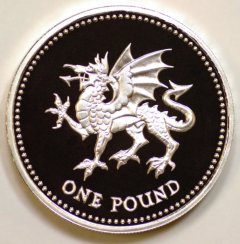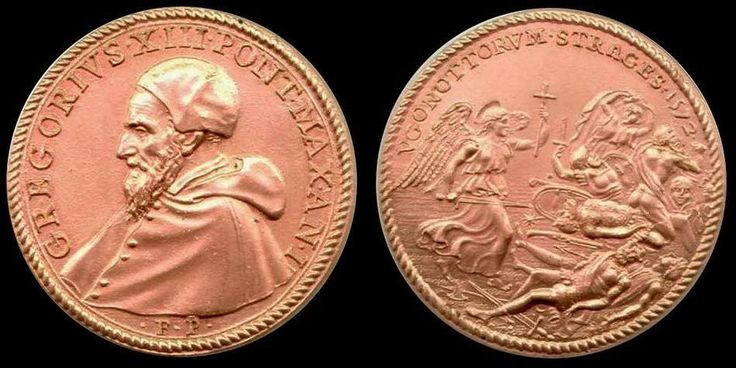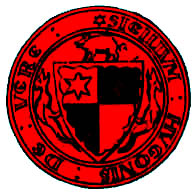
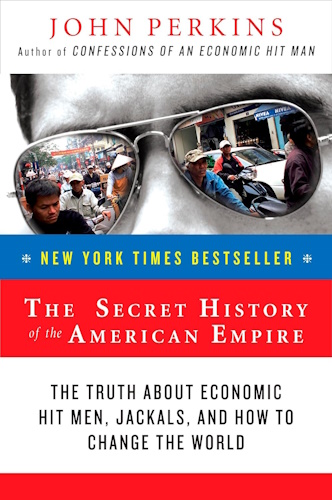

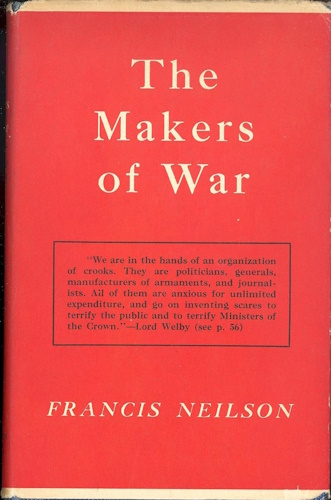

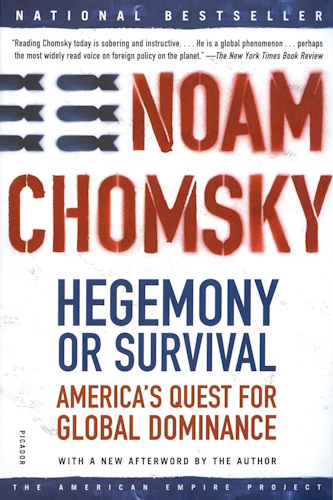



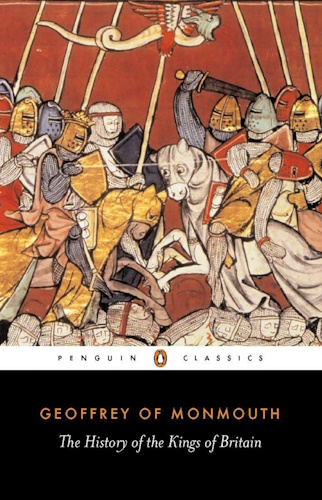

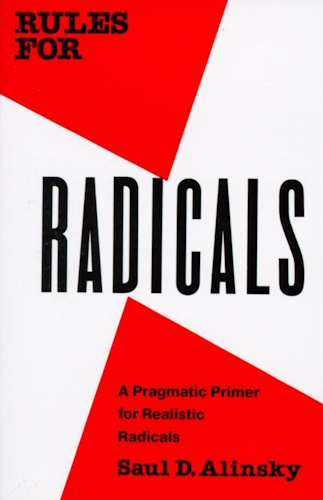

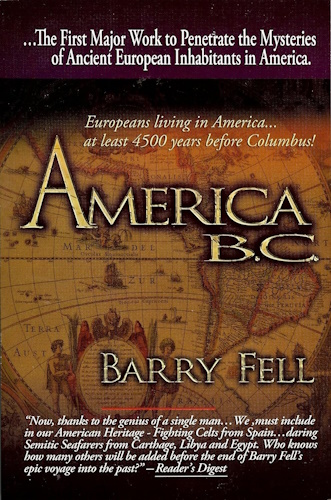

Whence & Pence
A Series
by
Douglas V. Gnazzo
January 6, 2005 - April 18, 2005
(Retrieved from archive.org)
![]()
Part 5: The Pounding
February 16, 2005
NEW SEEDS
After the fall of the Roman Empire, a major migration of diverse peoples and cultures began to unfold, spreading out across Europe. The migration gradually evolved, over the course of decades and centuries, progressing with both the slowness, and the power, of a mighty glacier, carving out and giving form to: the Dark Ages, The Middle Ages, and the Renaissance.
The face of the land completely changed from that of the former empire, as new territories and kingdoms were now based upon tribes of people led by powerful noble families: the Ostrogoths in Italy, Visigoths in Spain, Franks in Gaul, and the Saxons and Normans in England.
With the rise to power of the Franks, Rome never again regained the position of world dominance it once held, nor did it ever give serious contest to the Frankish kingdom that came to rule the West, which still remained under the suzerainty of the Pope, as it was he that bequeathed the crown of the Holy Roman Emperor. The Franks were of two dynasties: the Merovingians, and the Carolingians, their roots extending back to the Goths before them.
Recall in Whence & Pence, Part 4: The Resounding that the invasion of Italy by the Normans, under the leadership of Robert Guiscard, took place in the early 1050's. During this period of history, the Normans and the Pope were bitter enemies.
Robert Guiscard and Roger I conquered many areas of Southern Italy and Sicily; consequently, the Pope decided that if he couldn't beat them, then he might as well join them. So he made the Normans his ally, bestowing southern Italy to them as a fief, in return for their pledge of fealty and promise to defend the Church, against the Pope's most powerful enemy: the German Emperors. Note his most worrisome enemy were not the Muslims, but the Germans, almost surprising he didn't sound a call to arms against the Germans, then again, maybe he did.
From 1035 to 1266 the Normans dominated Italy; first without the Pope's blessing, and then eventually with his consent. The Pope wanted to end the rule of the Hohenstaufen line from Germany. A deal was struck with Charles of Anjou, the brother of King Louis IX of France. Charles killed the emperor's illegitimate son Manfred, and his legitimate grandson Conradin. The House of Anjou now ruled the Kingdom. The Pope could now give his old knees a rest.
By 1282, Charles ruled Sicily, southern Italy, Jerusalem, Albania, Provence, Anjou, Maine and parts of Tunisia. He also had his gaze fixed on Constantinople, which would have brought the Byzantine Empire, including the Eastern Orthodox Church, under the Pope in Rome's control, which, needless to say, would have made the Pope very happy. Charles d'Anjou was now the most powerful European monarch of his time, with the Pope's blessing of course; as somebody had to get on their knees, 'tis only fitting to pay homage.
The House of d'Anjou is said to have ruled until 1435, with the apparent ending of the Angevin dynasty, but as usual, appearances can be deceiving; as René I the Good of Anjou, Duke of Lorraine, procured the domain and the line. Blood is blood, names are just that – names; and the House of Lorraine and the House of Guise both contained the blood of the House d'Anjou, as the limbs of a tree or Plant – ard, branch off into other limbs, yet share the same common roots and sap.
CULTIVATION
The Knights of the Temple and the Knights Hospitaller formed the first international network of banks. Starting in the 1100's and increasing through each of the successive centuries, bills of exchange were becoming the most popular and widely used financial instrument in foreign trade and exchange.
Because of their extensive travels across the globe, coupled with their reputation for fighting and bravery, the Knights were in the unique position of being able to offer such financial services. The Knights also had fleets of ships and castles throughout the land, providing a significant and impressive infrastructure for more than just banking, especially for the shipping of goods.
Italy was geographically situated to be the world's middleman of international trade. Rome, Venice, Genoa and other cities were home to a host of powerful banking families, all more than willing to provide the ways and means needed to finance international trade. Also, Rome was the location of Vatican City and the Holy Roman Catholic Church, one of the world's largest moneyed institutions.
Athough the initial center of banking was located in Italy, along with the huge migration of peoples across Europe, so too was banking spreading out: to France, Germany, Spain, England and elsewhere. Many of the large banking families had Houses in different countries, to be better able to facilitate international trade and commerce. Positions on the game board were changing – the game remained the same, but the strategic centers were now different. The Knights had always maintained a large central castle in the center of London, which provided a focal point of finance in England and Europe.
Prior to the rise of the House of Medici, there were the Peruzzi, Bardi, Albizzi, Pazzi, Balbi, and several other powerful banking families, including the House of Orsini. At first the Church in Rome used different bankers, but eventually it chose the Medici's, and accounted for almost half of their revenue. All the large banking houses looked upon the Church as the goose that laid the golden eggs, and all wanted to be her banker. The Medici held that exalted seat, as did the Rothschilds that followed after them.
MEDIEVAL BANKS
Evidence of banking goes back to ancient Sumeria, Egypt, and Greece; Babylon was a focal point. The code of Hammurabi included listings of various rates of interest, and dates back to the 18th century BC. The history of the close relationship between national banks and government debt issuance has historically been kept hidden from public view because it is a basically an immoral arrangement of mutual greed and convenience, between the bankers and the government:
The most sophisticated banking system of the later ancient world was Rome, as Rome dominated the world for centuries, hence it was home to a vast treasure of wealth.
"As lending upon interest was forbidden by the Gabinian law between provincials and Roman citizens, and the latter at that time had all the money of the globe in their hands, there was a necessity for tempting them with the bait of extravagant interest, to the end that the avaricious might thus lose sight of the danger of losing their money. And as they were men of great power in Rome, who awed the magistrates and overruled the laws, they were emboldened to lend, and to extort great usury. Hence the provinces were successively ravaged by every one who had any credit in Rome: and as each governor, at entering upon his province, published his edict wherein he fixed the rate of interest in what manner he pleased, the legislature played into the hands of avarice, and the latter served the mean purposes of the legislator.
As soon as lending upon interest was forbidden at Rome, they contrived all sort of means to elude the law; and as their allies, and the Latins, were not subject to the civil laws of the Romans, they employed a Latin, or an ally, to lend his name, and personate the creditor. The law, therefore, had only subjected the creditors to a matter of form, and the public were not relieved." [Baron de Montesquieu, The Laws of Nations]
There were several families in Rome involved in the business of banking; however, one family had a great effect, not only on banking, but on world history as well – the House of Medici.
The House of Medici established the first major medieval bank in 1397. Their main competitor at the time was the House of Fugger from Graben, nearby to Augsburg. Both families established dominant banking dynasties, amassing huge fortunes.
Some of the first important banks of Europe were: the Bank of Barcelona (1401); the Bank of St. George (1407); the Bank of Genoa (1587); the Bank of Amsterdam (1609); bank of Hamburg (1619) the Bank of England (1694); and the Bank of Scotland (1695). As shown in Honest Money, Part V: History of American Money and Banking the first major bank in the United States was the Bank of North America (1792).
THE HOUSE OF MEDICI
The Medici family was one of the most powerful European families, from whence came three Popes, two Queens of France, and a line of Grand Dukes of Tuscany; as well as one of the wealthiest and most influential banking houses of Europe.
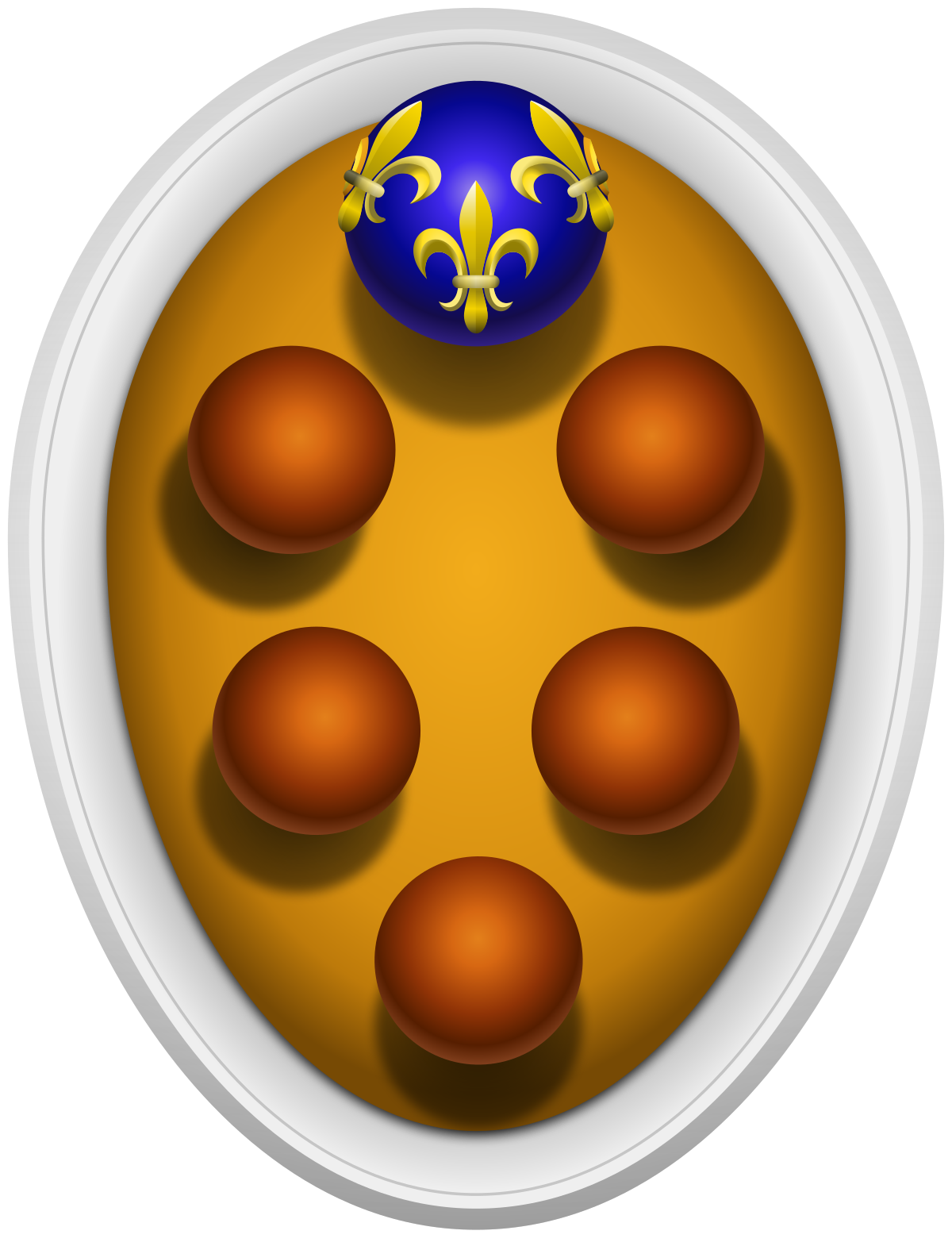
Cosimo Medici was involved in the esoteric world of the occult, as well as the arts, to which he contributed immensely, as did his descendents after him. Lorenzo Medici continued his family's patronage of the arts. Leonardo D'Vinci, Michelangelo and Botticelli were supported and then commissioned by the Medici family, and looked to them for financial backing and protection, which they received.
Although their coat of arms appears to be plain and simple, it also contains occult symbolism, which can be more easily observed by drawing a horizontal line through the center, dividing the above three balls from the below three balls.
René d'Anjou had a huge influence on Cosimo Medici, largely due to Cosmo's penchant for the occult. Rene was one of the Grand Masters of the Prieure de Sion, which was of great interest and importance to Cosimo, who spent fortunes procuring ancient manuscripts, scrolls, books, and other arcane artifacts. Both Botticelli and Leonardo de Vinci became Grand Masters as well.
The Medicis relied on the oldest trick in the book to secure their family's position of dominance and power – marriage ties with other wealthy, powerful, and royal families. The French Royalty was their strongest ally.
Lorenzo's great granddaughter, Catherine, married King Henry II of France. Three of her sons became Kings of France, and her daughter Margaret married King Henry of Navarre. Margaret did not bare any children. Henry, however, married another Medici, Maria, who was the mother of King Louis XIII.
The influence the Medici's had on history is significant, for a synopsis of their impact the following timeline of events is an excellent source: Channel 4 - History - The Medici: A chronology.
The Medici's reign of power was filled with murder, intrigue, plots, and coups, some that took place right in Church; however, Catherine Medici was quite the piece work - the family jewel, as she is attributed with causing the St. Bartholomew's Day Massacre of 1572. The horrendous slaughter of men, women, and children took the lives of over 50,000 people in Paris alone and the carnage was said to have lasted for over two weeks – the reason: religious intolerance of the French Protestants involved in the Reformation.
What did Pope Gregory XIII – the Vicar of Christ on Earth – think about such merciless killing? He praised Catherine and commissioned a metal to be cast in honor of the event, with the inscription "Slaughter [strages] of the Huguenots."
That is one heck of a commemorative coin and is beyond the bounds of reason and sanity; it is incredulous that a Pope minted it. No further comment is needed, as the coin speaks for itself.
THE BANK OF AMSTERDAM
The Bank of Amsterdam, also known as the WisselBank, was founded in 1609. It preceded the Bank of England by 85 years. From whence came the need for such a bank? From the need for the financing of trade – but what trade? The Spice Trade.
For thousand of years the trading of spices had taken place, with records going back 2500 years before Christ in Egypt and Sumeria. As discussed in part four, the resounding, trade and trade routes have always been the focal point of contention between nations. Originally, the spice trade was done over land before man learned the ways of the sea.
The spice of preference was pepper, sometimes trading for more than its weight in gold. The home to the pepper trade was India. The term black gold originally applied to pepper, not to oil, that was to come later. Other spices in demand were salt, cumin, curry, marjoram, and nutmeg.
Spain and Portugal were sending out ships to navigate the world, trying to find the shortest, safest, and most direct trade route to the Indies. By 1500 the Portuguese dominated trade with India. England and Holland wanted in on the action. There was much political and financial posturing taking place, all to strengthen and maintain the existing elite power structure.
Alfonso Borgia became Pope Callistus III in 1455. His nephew, Rodrigo, became Pope Alexander VI in 1492. One of the first acts of Pope Alexander VI was to decree a papal bull, Inter caetera, 1493 - Alexander VI dividing the new world between Spain and Portugal. Remember the name Borgia.
Both England and Holland established trading companies to try to monopolize trade with India, known as the East and West India Companies, England in 1600, and the Dutch in 1602. The Dutch, however, were much more organized and efficient than England. By 1609 the Dutch were selling shares of stock in the company, the first financial transaction of its kind.
The Wisselbank was the central bank of Amsterdam, discounting both foreign and domestic bills of exchange. It loaned money to the city of Amsterdam and to the State as in the providence of Holland. In 1683, it provided loans to the private market as well. Other banks, financial institutions and insurance companies followed suit.
"Amongst those thought to have "provided for a retreat" in this way were members of the English Commonwealth Parliament and the Danish court, the Prince Palatine and the Republic of Venice. The Wisselbank was also used by the Spanish crown to pay subsidies to Sweden in the 1660's. To this extent the Wisselbank was not only a public bank for Amsterdam and its citizens but also a secure haven for other European governments and political interests. Its success continued well into the eighteenth century, even after Amsterdam's ascendancy was coming to an end, and it survived until 1820." [Edwin Green, Banking An Illustrated History]
By 1670 the Dutch East India Company was the wealthiest corporation in the world, employing 50,000 workers; it owned a fleet of over 200 ships, and it's stock was quite profitable, paying a dividend of almost 40%.
PRIOR TO THE BANK OF ENGLAND
The silver penny was introduced to England around the year 785 by King Offa of Mercia, however, the term Sterling was not yet in use. For the next 500 years, the penny was the only coin minted in England. The silver coins were used not only in commerce, but also in payment of a type of tax known as tallage, which was the forerunner of property tax. Prior to being called tallage, this protection payment was referred to as Danegeld, because of its use as tribute money to the Danish King, so that he wouldn't pillage and plunder the English countryside.
The pound as a unit of currency derived its name from the weight or value of a Troy pound of a fineness of silver called sterling. However, it wasn't until 1528 that King Henry VIII set the standard as such. At first, the silver penny was between 20-22.5 grains of fine silver. Eventually the coin weight became standardized as being 1/240 of a Tower pound of weight and was set to 925/1000 finesse by King Henry II, in 1158.
In modern times the pound has replaced the penny as the basic unit of currency – as inflation has steadily eroded the value of the currency. Originally a silver penny had the purchasing power of slightly less than a modern pound.
THE BANK OF ENGLAND
The English merchants were envious of the Dutch traders that had access to a central bank, a stock exchange, and a debt market that all provided financing for world trade; they too wanted easy access to the credit markets. For some reason, they thought there wasn't enough pence to go round, or what some call – liquidity. They were under the spell of the quantity theory of money; a deadly spell that still holds man under its sway. But from whence comes this illusion?
The want of greed, leads to many a deed
But be aware the way that leads astray
The end of the revolution saw William of Orange and Queen Mary acquire the throne of England. King William was a moneychanger from Holland, and he was a descendent from the House of Orange. Some say the Bank of Rome was the unseen hand, guiding the way.
The idea of a central bank had been bandied about for some time, but upon the arrival of William the debate heated up. William Patterson is credited with the formal proposal and script for the bank. Most telling was Patterson's description of his plan, for a "Bank of England", and for a "Fund for Perpetual Interest."
King William was an experienced moneychanger, and he knew a good scheme when he saw one, so he guided the proposal for the bank through Parliament, with the help of Charles Montagu, Chancellor of the Exchequer.
Naturally, an invitation to the public to invest in the new project was offered. The initial subscriptions totaling £1.2 million were the capital stock of the bank, and were lent to the Government in return for the Royal Charter, an act of one hand washing the other. The dice had been rolled; the game had begun – the beast known as the funded national debt was born.
"There is something so consummately ridiculous in the idea of a nation's getting money by paying interest to itself upon its own stock, that the mind of every rational man naturally rejects it. It is, really, something little short of madness to suppose, that a nation can increase its wealth; increase its means of paying others; that it can do this by paying interest to itself. When time is taken to reflect, no rational man will attempt to maintain a proposition so shockingly absurd." [William Cobbett M.P., Paper Against Gold]
As explained in Honest Money, Part VIII: Final Summary and Conclusions:
"Instead, a new system was created – based on future tax revenues of the State. The prospective sum total of receipts was used as the base upon which to borrow large sums of money, by the issuing of bonded debt; thus allowing for only a slight increase in taxes, enough to pay for the service on the outstanding debt; or better yet, no increase at all. This created the elite international moneychangers dream: the grand illusion of ever-expanding debt and a perpetual interest rate stream, masquerading as the increased wealth of the People.
This is how the creature known as the national debt was born; suckled at the breast of taxes; nourished by ever-larger bits and pieces of private property; men, women, and children's lives of toil tossed as scraps to feed the beast. Such a system is the work of a master magi, adept in the arts of deception, performing the grand illusion."
During the 17th century, the ideas of money, credit, and debt were beginning to take on a new face, similar to that of Janus. The elite international bankers were trying to convince the world, of the false belief, that wealth can be created by the extension of credit money based on debt, in the form of paper fiat currency, issued according to fractional reserve lending principles. For a more detailed explanation see: GOLD: Sovereign of Sovereigns and Scylla & Charbydis: The Scourge of Mankind.
The Bank of England fulfilled its role admirably, as it lined the banker's vaults with profits, at the expense of the average working man, conned into the game of debt. The National Debt of England grew from £12 million in 1700 to £850 million by 1815, which earned a whole lot of interest for someone – that didn't actually own the money that was lent out to "earn" the interest, which some would call fraud or embezzlement.
Make no doubt about it, the Bank of England did provide credit and plenty of it. But behind the scenes, out of sight and out of mind, was the unseen hand, deftly guiding the power of the pence to do its bidding: the paw prints of England can be seen throughout the world: India, China, Australia, America, and Africa – to name but a few victims that took a pounding.
RISE OF ENGLAND
England was the first country to experience an industrial revolution. What was the reason why the English gained the coveted position of being the first nation to experience such a transformation? Were the English people smarter than the French, were the English harder workers than the Germans, were the English more commercially developed than Italy? Then why did this very important part of history occur as it did?
Just as the sinews of war is money, so too are the sinews of industry money – money is the lubrication of the wheels of commerce and trade. Once man took the giant step past barter and direct exchange, into the world of indirect exchange, money and the art of finance took center stage. Especially involved was the concept of credit – intricately wound round the concept of debt. Money, credit, and debt – the three shades of the financial world: hear no evil, speak no evil, and see no evil. Studied by few, understood by even less.
With the end of the Roman Empire, civilization began to increasingly spread across Europe, taking decades and centuries to complete. As the paradigm shift progressed, eventually England came to be the center of world finance. This is the ultimate reason why England first experienced the industrial revolution – because it had access to the means to finance it. The international bankers and financiers moved along with the migration and centered themselves accordingly.
These banking families were the heirs to the Old World Roman oligarchy, which had migrated to Europe during the period from the 1400's -1700's, establishing a New World Order of an Anglo-Dutch-Swiss extraction. England came to be the financial center of this new order. The geography may have changed, but the bloodlines remained essentially the same. This is a crucial distinction, as geographic locations may change, the names of nations may change, the names of families may change, but if the bloodlines behind it all knowingly remain the same, and knowingly exert their families dominance over and from whatever part of the world they happen to presently reside in – the game remains in the hands of the same few players, who over time, collect all the winnings of the game, which might just explain how one half of one percent of the world's population came to own 95% of everything. Concentration of wealth may not be by happenchance.
ELITIST IDEOLOGY
Prime Minister Disraeli had mentioned secret societies that could thwart the workings of governments in a single stroke, indicating much power lay hidden behind the scenes. Considering the rise to world dominance by England, the question naturally arises, was this rise to ruler of the western world helped along by the secret societies that Prime Minister Disraeli of England referred to?
Dr. Carroll Quigley was a professor of western civilization and history. He received a doctorate degree from Harvard University in 1938. He later taught at Princeton, Harvard, and at Georgetown. He was a consultant for the Brookings Institution, the Defense Department, the State Department, and the Navy. He has written numerous books on world history and civilization. He stated that he was directly associated with such elite secret groups.
"The goals which Rhodes and Milner sought and the methods by which they hoped to achieve them were so similar by 1902 that the two are almost indistinguishable. Both sought to unite the world, and above all the English-speaking world, in a federal structure around Britain. Both felt that this goal could best be achieved by a secret band of men united to one another by devotion to the common cause and by personal loyalty to one another. Both felt that this band should pursue its goal by secret political and economic influence behind the scenes and by the control of journalistic, educational, and propaganda agencies.
This organization has been able to conceal its existence quite successfully, and many of its most influential members, satisfied to possess the reality rather than the appearance of power, are unknown even to close students of British history.
This is the more surprising when we learn that one of the chief methods by which this Group works has been through propaganda. It plotted the Jameson Raid of 1895; it caused The Boer War; it set up and controls the Rhodes Trust; it created the Union of South Africa in 1906-1910; it established the South African periodical The State in 1908; it founded the British Empire periodical The Round Table in 1910, and this remains the mouthpiece of the Group; it has been the most powerful single influence in All Souls, Balliol, and New Colleges at Oxford for more than a generation; it has controlled The Times for more than fifty years, with the exception of the the three years 1919-1922; it publicized the idea of and the name "British Commonwealth of Nations" in the period 1908-1918; it was the chief influence in Lloyd George's war administration in 1917-1919 and dominated the British delegation to the Peace Conference of 1919; it had a great deal to do with the formation and management of the League of Nations and of the system of mandates; it founded the Royal Institute of International Affairs in 1919 and still controls it; it was one of the chief influences on British policy toward Ireland, Palestine, and India in the period 1917-1945; it was a very important influence on the policy of appeasement of Germany during the years 1920-1940; and it controlled and still controls, to a very considerable extent, the sources and writing of the history of British Imperial and Foreign Policy since the Boer War." [Carroll Quigley]
Such thinking is very similar to the mindset of the earlier elitists that relied on either Royal or Divine Descent to secure their positions of world dominance. We have seen thousands of people executed, tortured, massacred, and slaughtered at the hands of knights, religious orders, as well as from the direct decrees of Popes, Kings and Queens, with some of the diabolical events commemorated by coins and engravings. The elite supremacists have always been under such delusional thinking, which is summed up by the following:
"Responsible government can only be realized for any body of citizens in so far as they are fit for the exercise of political power. In the Dependencies the great majority of the citizens are not as yet capable of governing themselves and for them the path to freedom is primarily a problem of education.
The Commonwealth is a typical section of human society including every race and level of civilization organized in one state. In this world commonwealth the function of government is reserved to the European minority, for the unanswerable reason that for the present this portion of its citizens is alone capable of the task-civilized states are obliged to assume control of backward communities to protect them from exploitation by private adventurers from Europe.
The Commonwealth cannot, like despotisms, rest content with establishing order within and between the communities it includes. It must by its nature prepare these communities first to maintain order within themselves. The rule of law must be rooted in the habits and wills of the peoples themselves. The peoples of India and Egypt, no less than those of the British Isles and Dominions, must be gradually schooled to the management of their national affairs.
It is not enough that free communities should submit their relations to the rule of law. Until all those people control that law the principle by which the commonwealth exists is unfulfilled. The task of preparing for freedom the races which cannot as yet govern themselves is the supreme duty of those races who can. It is the spiritual end for which the Commonwealth exists, and material order is nothing except a means to it.
In India the rule of law is firmly established. Its maintenance is a trust, which rests on the government of the Commonwealth until such time as there are Indians enough able to discharge it. India may contain leaders qualified not only to make but also to administer laws, but she will not be ripe for self-government until she contains an electorate qualified to recognize those leaders and place them in office.
For England the change is indeed a great one. Can she face it? Can she bear to lose her life, as she knows it, to find it in a Commonwealth, wide as the world itself, a life greater and nobler than before? Will she fail at this second and last crisis of her fate, as she failed at the first, like Athens and Prussia, forsaking freedom for power, thinking the shadow more real than the light, and esteeming the muckrake more than the crown?" [Lionel Curtis]
"Thus I helped the tyrant of the gods and with this foul payment he has responded;
for it is a disease that is somehow inherent in tyranny to have no faith in friends."
[Prometheus 1. Aeschylus, Prometheus Bound 225]
![]()
© 2005 Douglas V. Gnazzo
![]()
![]()
![]()
Disclaimer:
Some material presented will contain links, quotes, ideologies, etc., the contents of which should be understood to first, in their whole, reflect the views or opinions of their editors, and second, are used in my personal research as "fair use" sources only, and not espousement one way or the other. Researching for 'truth' leads one all over the place...a piece here, a piece there. As a researcher, I hunt, gather and disassemble resources, trying to put all the pieces into a coherent and logical whole. I encourage you to do the same. And please remember, these pages are only my effort to collect all the pieces I can find and see if they properly fit into the 'reality aggregate'.
Personal Position:
I've come to realize that 'truth' boils down to what we 'believe' the facts we've gathered point to. We only 'know' what we've 'experienced' firsthand. Everything else - what we read, what we watch, what we hear - is what someone else's gathered facts point to and 'they' 'believe' is 'truth', so that 'truth' seems to change in direct proportion to newly gathered facts divided by applied plausibility. Though I believe there is 'truth', until someone representing the celestial realm visibly appears and presents the heavenly records of Facts And Lies In The Order They Happened, I can't know for sure exactly what "the whole truth' on any given subject is, and what applies to me applies to everyone. Until then I'll continue to ask, "what does The Urantia Book say on the subject?"
~Gail Bird Allen
![]()
![]()














-
Urantia Book, 44:0.11 - The Celestial Artisans
Never in your long ascendancy will you lose the power to recognize your associates of former existences. Always, as you ascend inward in the scale of life, will you retain the ability to recognize and fraternize with the fellow beings of your previous and lower levels of experience. Each new translation or resurrection will add one more group of spirit beings to your vision range without in the least depriving you of the ability to recognize your friends and fellows of former estates.
-
Princess Bride 1987 Wallace Shawn (Vizzini) and Mandy Patinkin (Inigo Montoya)
Vizzini: HE DIDN'T FALL? INCONCEIVABLE.
Inigo Montoya: You keep using that word. I do not think it means what you think it means. -
Urantia Book, 117:4.14 - The Finite God
And here is mystery: The more closely man approaches God through love, the greater the reality -- actuality -- of that man. The more man withdraws from God, the more nearly he approaches nonreality -- cessation of existence. When man consecrates his will to the doing of the Father's will, when man gives God all that he has, then does God make that man more than he is.
-
Urantia Book, 167:7.4 - The Talk About Angels
"And do you not remember that I said to you once before that, if you had your spiritual eyes anointed, you would then see the heavens opened and behold the angels of God ascending and descending? It is by the ministry of the angels that one world may be kept in touch with other worlds, for have I not repeatedly told you that I have other sheep not of this fold?"
-
Urantia Book, Foreword - 0:12.12 - The Trinities
But we know that there dwells within the human mind a fragment of God, and that there sojourns with the human soul the Spirit of Truth; and we further know that these spirit forces conspire to enable material man to grasp the reality of spiritual values and to comprehend the philosophy of universe meanings. But even more certainly we know that these spirits of the Divine Presence are able to assist man in the spiritual appropriation of all truth contributory to the enhancement of the ever-progressing reality of personal religious experience—God-consciousness.
-
Urantia Book, 1:4.3 - The Mystery Of God
When you are through down here, when your course has been run in temporary form on earth, when your trial trip in the flesh is finished, when the dust that composes the mortal tabernacle "returns to the earth whence it came"; then, it is revealed, the indwelling "Spirit shall return to God who gave it." There sojourns within each moral being of this planet a fragment of God, a part and parcel of divinity. It is not yet yours by right of possession, but it is designedly intended to be one with you if you survive the mortal existence.
-
Urantia Book, 1:4.1 - The Mystery Of God
And the greatest of all the unfathomable mysteries of God is the phenomenon of the divine indwelling of mortal minds. The manner in which the Universal Father sojourns with the creatures of time is the most profound of all universe mysteries; the divine presence in the mind of man is the mystery of mysteries.
-
Urantia Book, 1:4.6 - The Mystery Of God
To every spirit being and to every mortal creature in every sphere and on every world of the universe of universes, the Universal Father reveals all of his gracious and divine self that can be discerned or comprehended by such spirit beings and by such mortal creatures. God is no respecter of persons, either spiritual or material. The divine presence which any child of the universe enjoys at any given moment is limited only by the capacity of such a creature to receive and to discern the spirit actualities of the supermaterial world.
-
Urantia Book, 11:0.1 - The Eternal Isle Of Paradise
Paradise is the eternal center of the universe of universes and the abiding place of the Universal Father, the Eternal Son, the Infinite Spirit, and their divine co-ordinates and associates. This central Isle is the most gigantic organized body of cosmic reality in all the master universe. Paradise is a material sphere as well as a spiritual abode. All of the intelligent creation of the Universal Father is domiciled on material abodes; hence must the absolute controlling center also be material, literal. And again it should be reiterated that spirit things and spiritual beings are real.
-
Urantia Book, 50:6.4 - Planetary Culture
Culture presupposes quality of mind; culture cannot be enhanced unless mind is elevated. Superior intellect will seek a noble culture and find some way to attain such a goal. Inferior minds will spurn the highest culture even when presented to them ready-made.
-
Urantia Book, 54:1.6 - True And False Liberty
True liberty is the associate of genuine self-respect; false liberty is the consort of self-admiration. True liberty is the fruit of self-control; false liberty, the assumption of self-assertion. Self-control leads to altruistic service; self-admiration tends towards the exploitation of others for the selfish aggrandizement of such a mistaken individual as is willing to sacrifice righteous attainment for the sake of possessing unjust power over his fellow beings.
-
Urantia Book, 54:1.9 - True And False Liberty
How dare the self-willed creature encroach upon the rights of his fellows in the name of personal liberty when the Supreme Rulers of the universe stand back in merciful respect for these prerogatives of will and potentials of personality! No being, in the exercise of his supposed personal liberty, has a right to deprive any other being of those privileges of existence conferred by the Creators and duly respected by all their loyal associates, subordinates, and subjects.
-
Urantia Book, 54:1.8 - True And False Liberty
There is no error greater than that species of self-deception which leads intelligent beings to crave the exercise of power over other beings for the purpose of depriving these persons of their natural liberties. The golden rule of human fairness cries out against all such fraud, unfairness, selfishness, and unrighteousness.

